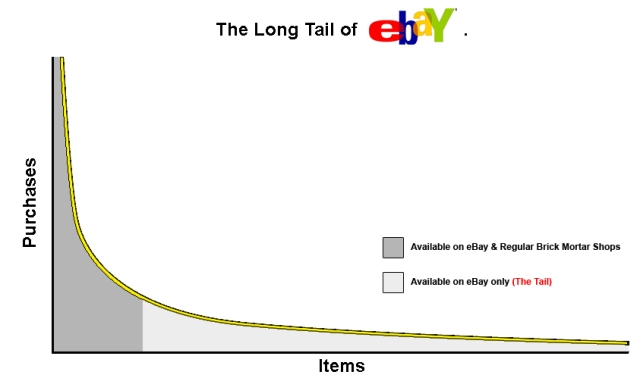![]()
Today’s topic will cover Leveraging the Long Tail in web 2.0 application patterns. Chris Anderson, Editor-in-Chief of Wired Magazine, has been discussing a concept he calls The Long Tail for quite some time now. “The theory of the Long Tail is that our culture and economy is increasingly shifting away from a focus on a relatively small number of “hits” (mainstream products and markets) at the head of the demand curve and toward a huge number of niches in the tail. As the costs of production and distribution fall, especially online, there is now less need to lump products and consumers into one-size-fits-all containers. In an era without the constraints of physical shelf space and other bottlenecks of distribution, narrowly-targeted goods and services can be as economically attractive as mainstream fare.” (Anderson, 2004). The Long Tail is about focusing on the less popular content that previously couldn’t be accessed because of some physical limitation: most often shelf space. (Porter, 2005)
I will be using eBay as an example to explain what The Long Tail is really about, thus the graph being tailored to eBay. The dark grey portion of the market refers to those items that are main stream and are available from regular retail outlets such as brick mortar stores. This comparatively small range of items comprises “the head” of the graph and essentially controls a large portion of the market. However, the light grey portion, which is referred to as “the long tail” is comprised of all other items which, although individually do not sell much, as a whole, comprise a sizeable market share. This situation can be summarized below:
Dark Grey: Few types of products, each sell high number of units
Light Grey: Large types of products, each sell low number of units
Now, if it isn’t obvious, the reason why the Long Tail is of a comparable size is because of the sheer number of non mainstream products out there. Although each individual product will not have a big market, it will have a Niche Market. The number of such Niche Markets adds up considerably to form this concept of “The Long Tail”. As a business, eBay has done a rather excellent job of cultivating this.
Here is an example of a product that might be found in a retail store:
Harvey Norman – PS3 160GB Gaming Console
And the same product on eBay
eBay – PS3 160GB Gaming Console
Here is a video explaining how eBay is using the long tail on their products and how they are making money from leveraging the long tail.
This “potential” in the long tail had previously been left untapped. This was due to many reasons, such as the small physical reach of traditional Brick Mortar stores, cost of purchasing inventory, storing and distributing the products. Only recently have these factors become negligible in cost, and have therefore allowed the tail’s potential to be recognised and cultivated.
Reference
Anderson, C. (2004). The Long Tail. Retrieved May 2012.
Porter, J. (2005). Long tail and Web 2.0. Retrieved May 2012.
O’Reilly T (2005) What is Web 2.0: Design patterns and Business model for next Generation of Software
Wikipedia (2012). The Long Tail. Retrieved May 2012.

